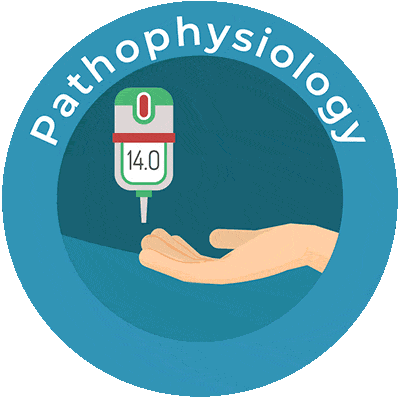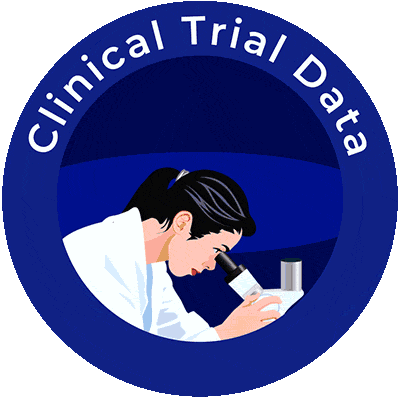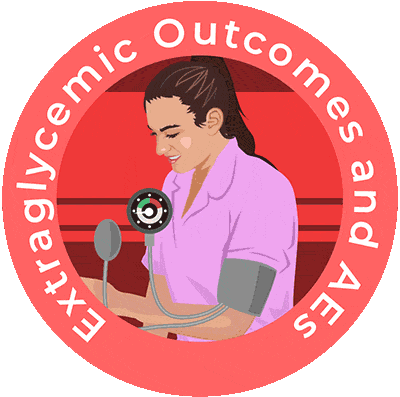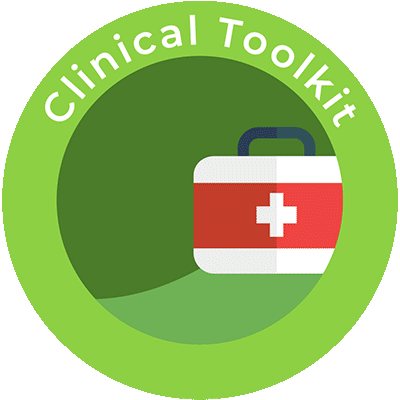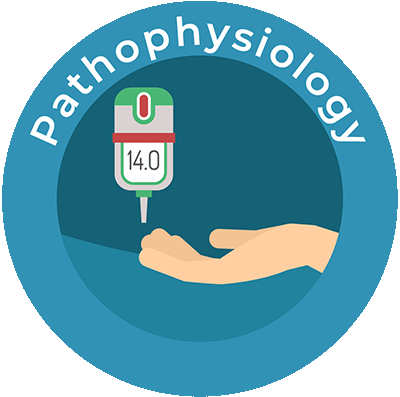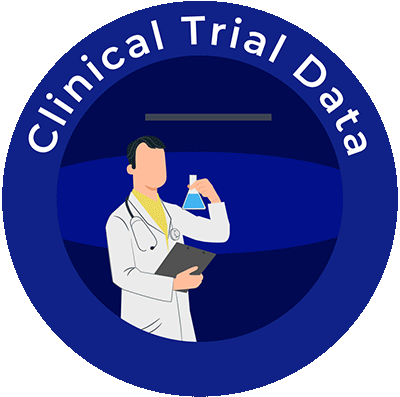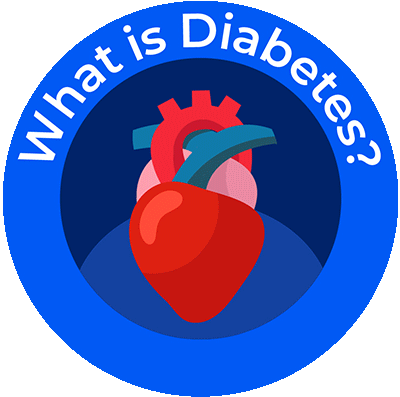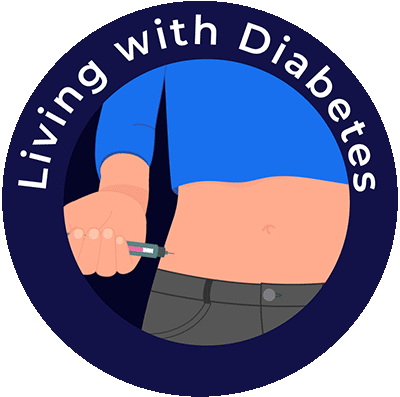Clinical Trial Data
GLP-1 receptor agonists as an add-on to oral glucose-lowering therapy have demonstrated an efficacy comparable to insulin treatment while also promoting weight loss and minimizing the risk of hypoglycemia in patients with type 2 diabetes. Below are brief summaries of select clinical trials on the efficacy and safety of available GLP-1 receptor agonists.
Exenatide (Twice daily and once weekly formulations)
- The DURATION-1 study compared exenatide once weekly with exenatide twice daily in patients with type 2 diabetes whose blood glucose was not controlled with diet and up to two oral therapies. After 30 weeks, exenatide once weekly significantly reduced HbA1c compared to the twice daily formulation (-1.9% vs -1.5%; P=0.0023). The percentage of patients achieving a glycemic goal <7% was also greater with exenatide once weekly (77% vs 61%; P=0.0039). Subjects in both treatment arms lost a similar amount of body weight (-3.7 and -3.6 kg from baseline for weekly and twice-daily dosing, respectively). An extension study to 52 weeks converted all subjects in the twice daily group to the weekly formulation. Patients who continued on the weekly dosing schedule maintained an HbA1c improvement (-2.0%) while those switching from twice-daily to once-weekly exenatide further reduced HbA1c to achieve a reduction similar to the subjects originally on exenatide once weekly.1,2
- The 24-week DURATION-5 study compared exenatide once weekly with exenatide twice daily. Exenatide once weekly significantly reduced HbA1c (-1.6% vs -0.9%; P<0.0001), lowered fasting glucose (-1.9 vs -0.7 mmol/L; P=0.008), and resulted in a greater proportion of patients achieving an HbA1c <7% (58% vs 30%; P<0.0001) compared to the twice daily treatment arm. A similar reduction in body weight was observed between groups.3
Liraglutide
- In the LEAD-6 trial, patients on maximally tolerated doses of metformin, sulfonylurea, or both were randomized to liraglutide or exenatide twice daily. Liraglutide significantly reduced HbA1c (-1.12% vs -0.79%; P>0.0001), while improving the proportion of patients achieving an HbA1c <7% (54% vs 43%; P=0.0015) compared to exenatide. The percentage of subjects achieving weight loss (liraglutide 78% vs exenatide 76%) and the amount of weight loss (liraglutide -3.24 kg vs exenatide -2.87 kg; P=0.22) were similar between the two treatment arms.4
- The DURATION-6 trial compared liraglutide with exenatide once weekly. Liraglutide was associated with a significant reduction in HbA1c from baseline (-1.48% vs -1.28%; P=0.02), a larger decrease in body weight (-3.57 kg vs -2.68 kg; P=0.0005), and a greater proportion of patients achieving an HbA1c <7% (60% vs 53%; p=0.0011) than exenatide once weekly. Both liraglutide and exenatide significantly reduced fasting plasma blood glucose from baseline (-2.12 vs -1.76 mmol/L; P=0.02).5
Semaglutide (subcutaneous formulation)
- A phase 3b trial of 1201 patients with HbA1c between 7.0% and 10.5% on metformin monotherapy were randomized to 0.5 mg semaglutide, 1.0 mg semaglutide, 0.75 mg dulaglutide, or 1.5 mg dulaglutide. Mean HbA1c from baseline was significantly reduced with 0.5 mg semaglutide compared to 0.75 mg dulaglutide (-1.5% vs -1.1%, P<0.0001) and with 1.0 mg semaglutide compared to 1.5 mg dulaglutide (-1.8% vs -1.4%, P<0.0001). Mean bodyweight from baseline was also significantly reduced with both doses of semaglutide (range, 4.6 kg to 6.5 kg) compared to dulaglutide (2.3 kg to 3.0 kg) (P<0.0001). Gastrointestinal disorders were reported in 43%-44% of semaglutide subjects and 33%-48% of patients receiving dulaglutide.6
- The SUSTAIN-4 trial investigated the efficacy and safety of subcutaneous 0.5 mg or 1.0 mg once-weekly semaglutide with once-daily insulin glargine in 1089 subjects with type 2 diabetes who had insufficient glycemic control with metformin with or without sulfonylureas. At week 30, 0.5 mg and 1.0 mg semaglutide significantly reduced mean HbA1c from baseline (-1.21% and -1.64%, respectively) compared to insulin glargine (-0.83%). Subjects in the 0.5 mg and 1.0 mg semaglutide arms achieved weight losses of 3.47 kg and 5.17 kg, respectively, versus a weight gain of 1.15 kg with insulin glargine. Fewer episodes of severe or blood glucose-confirmed hypoglycemia were reported with either dose of semaglutide (4%-6%) than with insulin glargine (11%). The most common adverse events were nausea with semaglutide and nasopharyngitis with insulin glargine.7
- The SUSTAIN-3 trial compared the efficacy of once-weekly semaglutide 1.0 mg subcutaneous with exenatide extended release 2.0 mg subcutaneous in 813 subjects taking oral antidiabetic medications. Semaglutide significantly reduced mean HbA1c from baseline compared to exenatide (-1.5% vs -0.9%; estimated treatment difference (ETD) vs. exenatide, -0.62%; P<0.0001 for noninferiority and superiority). Subjects receiving semaglutide also experienced a greater mean reduction in body weight from baseline than those receiving exenatide (-5.6 kg vs -1.9 kg; ETD, -3.78 kg; P<0.0001). An HbA1c <7.0% was achieved by significantly more subjects treated with semaglutide (67%) than exenatide (40%). Gastrointestinal adverse events were more common with semaglutide (41.8%) than exenatide (33.3%), and injection-site reactions were more frequent with exenatide (22.0%) than with semaglutide (1.2%).8
Semaglutide (oral formulation)
- Semaglutide (oral formulation) has been studied as monotherapy and in combination with metformin, sulfonylureas, sodium-glucose co-transporter-2 (SGLT-2) inhibitors, insulins, and thiazolidinediones in patients with type 2 diabetes. The efficacy of this agent was compared with placebo, empagliflozin, sitagliptin, and liraglutide. Oral semaglutide has also been studied in patients with type 2 diabetes with mild and moderate renal impairment. In patients with type 2 diabetes, oral semaglutide produced clinically significant reduction from baseline in HbA1c compared with placebo.9
- In PIONEER 1, a 26-week, phase 3a, randomized, double-blind, placebo-controlled, parallel-group trial conducted in 93 sites in nine countries, the superiority of three doses of oral semaglutide given once daily for 26 weeks in reducing HbA1c was confirmed versus placebo. The highest dose of oral semaglutide studied (14 mg daily) resulted in a mean reduction of 1.5%, from a baseline HbA1c of 8.0% (64 mmol/mol) to a final HbA1c of 6.5% (47 mmol/mol), and a body weight reduction of 4.1 kg, with 80% of patients achieving an HbA1c target of ,7% (53 mmol/mol). Oral semaglutide was well tolerated with the most common adverse event being transient mild or moderate nausea.10
Lixisenatide
- The GetGoal-X trial compared the efficacy and safety of lixisenatide to exenatide twice daily in patients with uncontrolled type 2 diabetes on metformin. The mean HbA1c change from baseline for lixisenatide was -0.79% compared to -0.96% for exenatide. This difference met predefined criteria for noninferiority. A similar proportion of patients in each group achieved an HbA1c goal <7% (48.5% for lixisenatide, 49.8% for exenatide). Body weight was significantly reduced in both groups, although a greater reduction was observed with exenatide (-2.96 kg for lixisenatide vs -3.98 kg for exenatide).11
Dulaglutide
- In the AWARD-1 study, dulaglutide 0.75 mg or 1.5 mg once weekly were compared with exenatide twice daily and placebo. Changes in HbA1c at 26 weeks were -1.51%, -1.30%, -0.99%, and -0.46% for the dulaglutide 1.5 mg, dulaglutide 0.75 mg, exenatide, and placebo groups, respectively (both doses of dulaglutide were superior to exenatide; P<0.001). A greater percentage of subjects achieved an HbA1c of <7% with dulaglutide 1.5 mg and 0.75 mg compared with exenatide (78% and 66% versus 52%; P<0.001 for both comparisons). Change in weight over 26 weeks was -1.30 kg, +0.2 kg, -1.07 kg, and +1.24 kg for dulaglutide 1.5 mg, dulaglutide 0.75 mg, exenatide, and placebo, respectively.12
- The AWARD-6 trial compared once weekly dulaglutide 1.5 mg with daily liraglutide. Mean change in HbA1c was -1.42% and -1.36% in the dulaglutide and liraglutide groups, respectively (noninferiority P-value<0.0001). An HbA1c <7% was achieved by 68% of subjects in both groups. Weight reduction was significantly greater with liraglutide compared with dulaglutide (-3.61 kg vs -2.90 kg; P=0.011).13
Liraglutide/insulin degludec
- The DUAL V trial assessed whether a fixed ratio of liraglutide and insulin degludec was noninferior to continued titration of insulin glargine in 557 patients with uncontrolled diabetes on insulin glargine and metformin. Reduction in HbA1c was greater with liraglutide/insulin degludec versus glargine (-1.81% vs -1.13%; P<0.001 for noninferiority; P<0.001 for superiority). Liraglutide/insulin degludec was associated with significantly greater average weight loss (-1.4 kg vs +1.8 kg; P<0.001) and fewer hypoglycemic events (episodes/patient-year exposure: 2.23 vs 5.05; P<0.001) than insulin glargine.14
- The 26 week, open-label DUAL-I trial investigated the efficacy and safety of liraglutide/insulin degludec to its components given alone in 1663 insulin-naïve patients. Liraglutide/insulin degludec was noninferior to insulin degludec (estimated treatment difference, -0.47%; P<0.0001) and superior to liraglutide (-0.64%; P<0.0001) in HbA1c reduction. Fewer participants in the liraglutide/insulin degludec treatment arm experienced gastrointestinal side effects compared to liraglutide (8.8% vs 19.7%).15
Lixisenatide/insulin glargine
- The LixiLan-L trial investigated the efficacy and safety of lixisenatide/insulin glargine compared with insulin glargine in 736 patients with uncontrolled diabetes on basal insulin and up to two oral antidiabetic medications. Lixisenatide/insulin glargine significantly reduced HbA1c compared to insulin glargine alone (-1.1% vs -0.6%; P<0.0001). An HbA1c value below 7% was achieved in 55% of patients receiving combination therapy and 30% of patients on insulin glargine alone. Mean body weight was significantly reduced with lixisenatide/insulin glargine compared to insulin glargine monotherapy (-0.7kg vs +0.7 kg; P<0.0001). Both treatment arms experienced similar rates of symptomatic hypoglycemia.16
References
- ElSayed NA, Aleppo G, Aroda VR, et al. 9. Pharmacologic approaches to glycemic treatment: Standards of care in diabetes-2023. Diabetes Care. 2023;46(suppl 1):S140-S157.
- Buse JB, Drucker Dj, Taylor KL, et al. DURATION-1: Exenatide once weekly produces sustained glycemic control and weight loss over 52 weeks. Diabetes Care. 2010;33:1255-1261.
- Blevins T, Pullman J, Malloy J, et al. DURATION-5: Exenatide once weekly resulted in greater improvements in glycemic control compared with exenatide twice daily in patients with type 2 diabetes. J Clin Endocrinol Metab. 2011;96:1301-1310.
- Buse J., Rosenstock J., Sesti G, et al. Liraglutide once a day versus exenatide twice a day for type 2 diabetes: A 26-week randomised, parallel-group, multinational, open-label trial (LEAD-6). Lancet. 2009;374:39-47.
- Buse J, Nauck M, Forst T, et al. Exenatide once weekly versus liraglutide once daily in patients with type 2 diabetes (DURATION-6): A randomised, open-label study. Lancet. 2013;381:117-124
- Pratley RE, Aroda VR, Lingvay I, et al. Semaglutide versus dulaglutide once weekly in patients with type 2 diabetes (SUSTAIN 7): A randomized, open-label, phase 3b trial. Lancet Diabetes Endocrinol. 2018;6:275-286.
- Aroda VR, Bain SC, Cariou B, et al. Efficacy and safety of once-weekly semaglutide versus once-daily insulin glargine as add-on to metformin (with or without sulfonylureas) in insulin-naïve patients with type 2 diabetes (SUSTAIN 4): A randomized, open-label, parallel-group, mulitcentre, multinational, phase 3a trial. Lancet Diabetes Endocrinol. 2017;5:355-366.
- Ahmann AJ, Capehorn M, Charpentier G, et al. Efficacy and safety of once-weekly semaglutide versus exenatide ER in subjects with type 2 diabetes (SUSTAIN 3): A 56-week, open-label, randomized clinical trial. Diabetes Care. 2018;41:258-266.
- ADA 2019 Oral Semaglutide – The PIONEER Program Trials. touchENDOCRINOLOGY. Accessed January 20, 2023. https://www.touchendocrinology.com/insight/ada-2019-oral-semaglutide-the-pioneer-program-trials
- Aroda VR, Rosenstock J, Terauchi Y, et al. PIONEER 1: Randomized clinical trial of the efficacy and safety of oral semaglutide monotherapy in comparison with placebo in patients with type 2 diabetes. Diabetes Care. 2019;42:1724-1732.
- Rosenstock J, Raccah D, Koranyi L, et al. Efficacy and safety of lixisenatide once daily versus exenatide twice daily in type 2 diabetes inadequately controlled on metformin: A 24-week, randomized, open-label, active-controlled study (GetGoal-X). Diabetes Care. 2013;36:2945-2951.
- Wysham C, Blevins T, Arakaki R, et al. Efficacy and safety of dulaglutide added onto pioglitazone and metformin versus exenatide in type 2 diabetes in a randomized controlled trial (AWARD-1). Diabetes Care. 2014;37:2159-2167.
- Dungan K, Povedano S, Forst T, et al. Once-weekly dulaglutide versus once-daily liraglutide in metformin-treated patients with type 2 diabetes (AWARD-6): A randomised, open-label, phase 3, non-inferiority trial. Lancet. 2014;384:1349-1357.
- Lingvay I, Perez Manghi F, Garcia-Hernandez P, et al. Effect of insulin glargine up-titration vs insulin degludec/liraglutide on glycated hemoglobin levels in patients with uncontrolled type 2 diabetes. The DUAL V randomized clinical trial. JAMA. 2016;315):898-907.
- Gough SCL, Bode B, Woo V, et al. Efficacy and safety of a fixed-ratio combination of insulin degludec and liraglutide (IDegLira) compared with its components given alone: Results of a phase 3, open-label, randomized, 26-week, treat-to-target trial in insulin-naïve patients with type 2 diabetes. Lancet Diabetes Endocrinology. 2014;2:885-893.
- Aroda VR, Rosenstock J, Wysham C, et al. Efficacy and safety of LixiLan, a titratable fixed-ratio combination of insulin glargine plus lixisenatide in type 2 diabetes inadequately controlled on basal insulin and metformin: The LixiLan-L randomized trial. Diabetes Care. 2016;39:1972-1980.

